2009 Ski-Doo MX Z Renegade 1200 4-TEC Review

New engine and wider chassis in trail machine
Serious trail riders who break trail in fresh powder or venture off forested fire roads look for steady power, quick handling, good flotation and, usually, the light weight you get from a 2-stroke powered sled. That means the serious off-trail riding options are Ski-Doo’s MX Z Renegade or Polaris’ Switchback models with either a 600cc or 800cc power package. If you want to give up 2-stroke power, but still want to break powder after the most recent snowstorm, there are options beyond Yamaha, which has gone totally 4-stroke across its model line.
Engine Type:Horizontal In-line
Cylinders:3
Engine Stroke:4-Stroke
Valve Configuration:DOHC
Displacement:1170.7 / 46.9
Starter:Electric
Turbocharged:No
View Full SpecAlthough both Polaris and Ski-Doo offer 4-stroke options in the off-trail segment, it’s our contention that the most serious backwoods riders will stay with 2-strokes and leave the 4-stroke extended track models for the adventure rider who rides trails way more often than breaks trail. This rider will look hard at the Polaris Turbo Switchback and all new for 2009 Ski-Doo MX Z Renegade 1200. Both are designed to offer an alternative to Yamaha’s Vector LTX. We find the non-turbo Ski-Doo Renegade 1200 matches up well with the Vector.
Similar Power, Less Weight
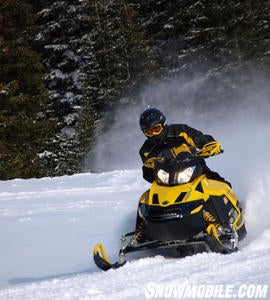 Plastic skis bite into the corner as Ski-Doo’s dual A-arm front suspension holds the grip.
Plastic skis bite into the corner as Ski-Doo’s dual A-arm front suspension holds the grip.
Right away there is a weight difference. Ski-Doo’s 4-stroke Renegade has 60 less pounds to drag through the powder than a Vector LTX. The Ski-Doo is even lighter than Yamaha’s brand new XTX with its lightweight aluminum platform, 144-inch track and claimed 542-lbs overall weight. Of course, Ski-Doo’s 1200 may be light when compared to the competition, but when compared to other Renegade models, it’s nearly 100-lbs heavier than the 600cc Renegade. But, of course, that’s comparing apples and oranges — or, should we say, REV-XP versus REV-XR platforms.
To accommodate its all-new Rotax 4-stroke triple, BRP/Ski-Doo engineers created a wider front bulkhead around the evolved REV-X chassis that appeared last season. The concept of centralizing engine and drive components low and back from the ski centerline is retained, but the simple mass of the new engine required a roomier engine compartment. Interestingly, if you look at Renegade specifications, the overall sled dimensions for both 2-stroke and 4-stroke models are nearly identical. The Renegade 1200 4-stroke is slightly taller.
When you sit astride the Renegade 1200 or even the similarly powered but shorter tracked MXZ Adrenaline, you know you’re on a bigger sled. The standard 16-in wide by 137-in long track provides ample flotation for off-trail excursions. A 1.25-inch lug profile provides added grip compared to a sport sled’s inch-tall lugs.
Smooth Power
If you are eyeing a 4-stroke sled for breaking trail, you already know that there are weight differences between any 4-stroke and 2-stroke crossover model. The Ski-Doo, Yamaha and Polaris Turbo 4-strokes will not have the same power characteristics as off-trail 2-strokes. In some conditions, despite the 4-stroke’s added weight, it may actually have an advantage with smoother power delivery, especially at drive-off. For example, the Renegade 1200 engages its TRA IV drive clutch and QRS secondary at a low 2,800 rpm. Ski-Doo’s 2-stroke Renegades come in a thousand revs higher. That’s not horrible, but the manageable low-end torque of the 1,171cc 4-stroke can be an asset when winding slowly in and around off-trail obstacles.
When designing its first snowmobile-specific 4-stroke triple, Rotax engineering drew on its decades-long knowledge of what characteristics snowmobilers needed. They recognized that snowmobilers wanted a wide powerband with ample torque. Considering today’s marketplace, including above average fuel efficiency became a must.
Rotax Triple Versus Genesis Triple
When Rotax began its quest to build the best new 4-stroke in snowmobiling, the engineering staff knew it had to go one better than Yamaha, whose Genesis 120 triple had to have been their benchmark. It was carbureted. The Rotax 4-stroke would be fuel injected to give it improved throttle response and computer-assisted efficiency. But, unexpectedly Yamaha threw a new engine into the mix and the advantages Rotax had against the Genesis 120 had to be compared versus Yamaha’s 130-hp, fuel-injected triple introduced in its all-new Nytro series.
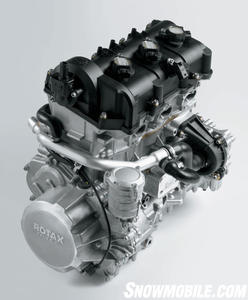 Delivering 130-hp the Rotax 1200 proves smooth and powerful across its wide powerband.
Delivering 130-hp the Rotax 1200 proves smooth and powerful across its wide powerband.
Even with that development, Rotax proved it had engineered an exceptionally good 4-stroke of its own. Compared to Yamaha’s Genesis 130FI, the larger displacement Rotax 1200 is claimed to develop more torque from about 5,500 rpm to peak power. Horsepower claims are similar at 130-hp for each.
The Rotax triple features double overhead cams with four valves per cylinder to maximize performance. There’s a counter balancer to control internal engine vibration.
Ski-Doo’s Renegade 1200 comes with a large 52mm single plenum throttle body that reacts smoothly and precisely, giving the rider a very easy throttle pull. As mentioned this set up gives the Renegade 1200 a real advantage when slogging through off-trail obstacles.
If you’ve read our initial review of the new Rotax 1200 4-stroke, we are not as taken with the engine’s exhaust sound as Ski-Doo marketing people seem to be. They wanted a Formula One type scream and we felt a broad NASCAR grunt would be the way to go. So, see which you prefer.
Even though the 4-stroke adds weight, Ski-Doo found ways to minimize the overall impact on the wider XR chassis. For example, the Renegade 1200 uses magnesium motor mounts, which weigh in at 328 grams versus the ‘heavier’ 662 grams of aluminum.
Ride Wise
The suspensions on the MX Z Renegade 1200 are similar to the 2-stroke models. You’ll find Ski-Doo’s latest double A-arm front unit equipped with Kayaba high-pressure gas shocks to control 9-inches of travel. The rear unit is an extended version of Ski-Doo’s fifth generation ‘SC-5’ parallel rail design. Kayaba shocks control the front and rear suspension arms and control upwards of 16-inches of rear travel. That places the Renegade 1200 ahead of both Yamaha’s Vector LTX and Nytro XTX as to maximum suspension travel front and rear.
The Renegade 1200 is not only smooth on — or off — the trail, but it is easy to maintain, making it a favorite for snowmobilers who want to break away whenever and wherever there’s snow.
Renegade 1200 owners will enjoy the fact that the engine’s oil and oil filter need be changed once a season or after 1,865 miles. We expect most Renegade 1200 owners will never own the sled long enough to reach the 12,500 miles suggested for valve adjustment.
But if you do keep this sled for a long time, Ski-Doo’s new chassis design will let you enjoy the Renegade 1200 for many years of extremely easy riding in just about any conditions. Off-trail riders will enjoy how they can react quickly to bumps or obstacles by standing up and weaving their way through the snow. Trail riders will appreciate the bridging effect of its 137-inch track that virtually eliminates the feel of nattering stutter bumps. All Renegade 1200 riders will embrace its smooth running, high-torque triple that is efficient with a gallon of fuel and can make smiles on a two-hundred mile day.
Renegade 1200 owners will quickly discover that the added heft it carries is offset by the ‘powderful’ advantages Rotax built into its first snowmobile-specific triple 4-stroke.
| 2009 Ski-Doo MX Z Renegade 1200 4-TEC Specs | |
| Engine | Rotax 1171cc 4-TEC 4-stroke; liquid-cooled; triple with 52mm single plenum throttle body injection |
| Horsepower | 130 (Estimated) |
| Drive | Ski-Doo TRA drive system with QRS secondary |
| Brake | Yamaha 4-piston hydraulic with lightweight, ventilated disc |
| Front Suspension | Ski-Doo double A-arm suspension; Kayaba HPG shocks; 9-inches of travel |
| Rear Suspension | Ski-Doo SC-5 parallel rail slide with Kayaba HPG shocks on front and rear arms; up to 16-inches of travel |
| Length | 122.4 in |
| Width | 47.9 in |
| Height | 47.2 in |
| Ski Stance | 47.0 in |
| Track | 16 x 137 x 1.25 Lightweight Rip Saw |
| Weight | 533 lbs (claimed) |
| Fuel Capacity | 10.6 US Gal |
| MSRP | $10,599 |



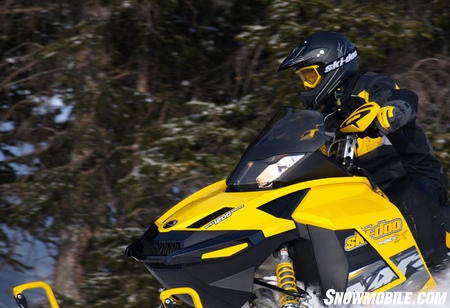
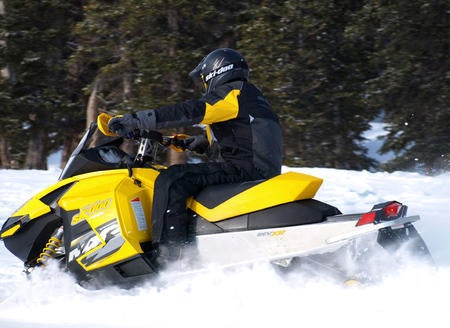
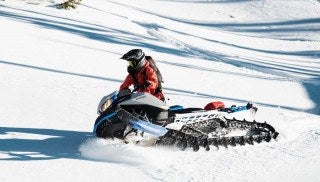
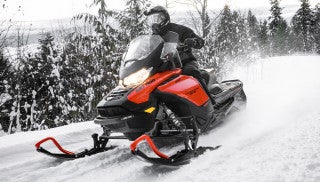



 Your Privacy Choices
Your Privacy Choices